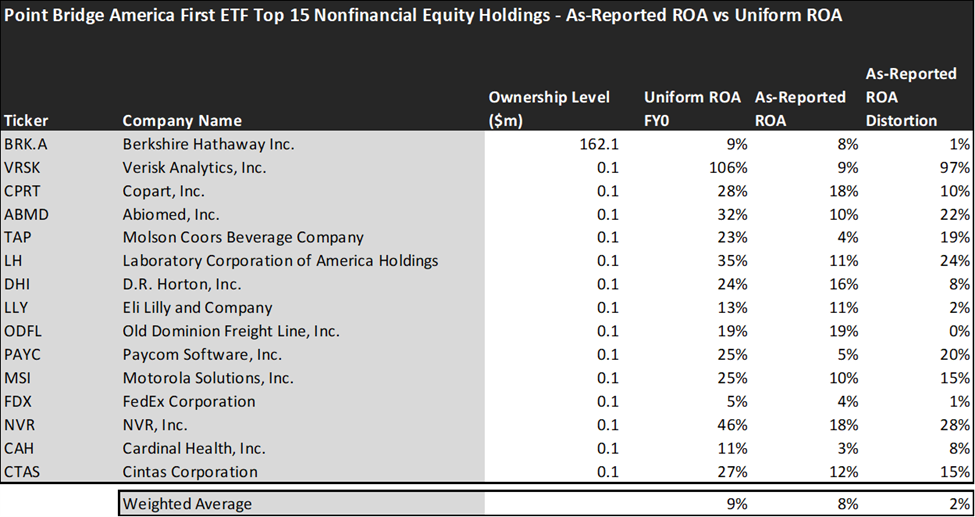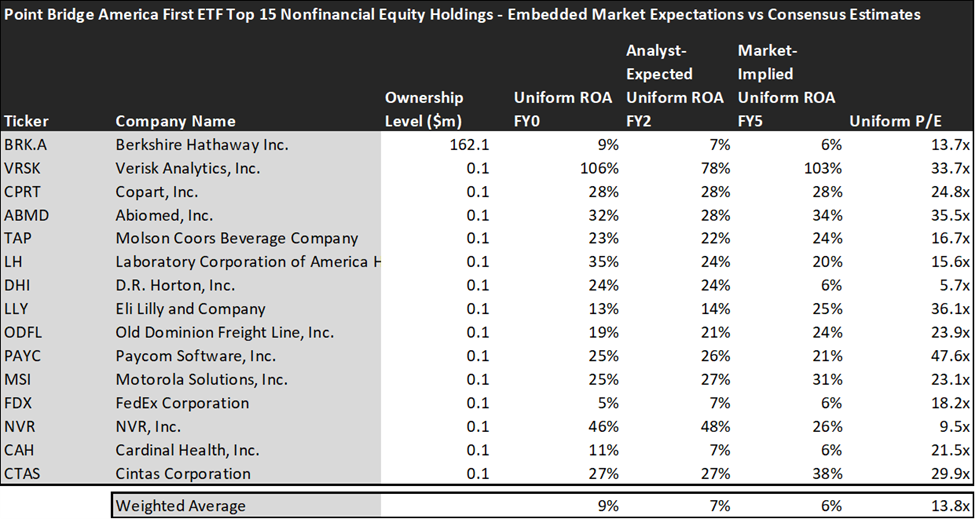Theme investing ETFs, such as principles-based ETFs, which screen out the stocks they find suitable to their principles and political or global long-term views, are getting increasingly popular. Today’s FA Alpha Daily will examine Point Bridge America First ETF (MAGA), which invests in companies that support the Republican party, to see if it unlocks value for investors.
FA Alpha Daily:
Friday Portfolio Analysis
Powered by Valens Research
As environmental, social, and governance (ESG) focused ETFs are entering the news, investors’ capital allocation has been changing.
Theme investing ETFs or funds are getting more and more popular each day, and different kinds of them started to show up in the investment industry.
One of the examples of this is principles-based ETFs.
These ETFs are screening out the stocks that they find suitable to their principles, and political or global long-term views. As ESG principles are becoming more and more popular to invest around, it only makes sense there has been a pushback to investing in other ideas.
Some are looking for companies with a strong “track record of creating American jobs” like The God Bless America ETF (YALL).
Another example is the Point Bridge America First ETF (MAGA), which invests in companies that support the Republican party.
Even though it may sound strange for some people to invest in a strategy that only considers political choices, the MAGA ETF already has more than $15 million in assets under management (AUM).
And it seems that investing in principles pays off as the MAGA ETF has been continuously outperforming S&P 500 since the beginning of 2022.
However, one important caveat is that owning the MAGA ETF is more like just owning Berkshire Hathaway (BRK.A), as it makes up more than 90% of the ETF’s holding.
It is up to investors to decide whether the MAGA ETF is as principled as the name suggests or it is just owning Berkshire Hathaway under a different name.
Let’s have a look at the MAGA ETF from the lenses of Uniform Accounting to see how investing in principles has been performing.
Economic productivity is massively misunderstood on Wall Street. This is reflected by the 130+ distortions in the Generally Accepted Accounting Principles (GAAP) that make as-reported results poor representations of real economic productivity.
These distortions include the poor capitalization of R&D, the use of goodwill and intangibles to inflate a company’s asset base, a poor understanding of one-off expense line items, as well as flawed acquisition accounting.
It is no surprise that once many of these distortions are accounted for, it becomes apparent which companies are in real robust profitability and which may not be as strong of an investment.
See for yourself below.


Using as-reported accounting, investors would think investing in an ETF, which allocates more than 90% of its capital to Berkshire Hathaway, is not really rewarding.
On an as-reported basis, many of these companies are poor performers in terms of profitability and operating with an average as-reported ROA of just 8% which is slightly below the corporate averages in the United States.
However, once we make Uniform Accounting (UAFRS) adjustments to accurately calculate earning power, we can see that the returns of the companies in Point Bridge America First ETF are much more robust.
The average company in the portfolio displays an impressive average Uniform ROA of 9%, which is higher than corporate average returns.
Once the distortions from as-reported accounting are removed, we can realize that Laboratory Corporation of America Holdings (LH) doesn’t have a ROA of 11%, but returns of 35%.
Similarly, NVR’s (NVR) ROA is actually 46%, not 18%. NVR is an American company engaged in home construction. It also operates a mortgage banking and title services business.
Verisk Analytics (VRSK) is another great example of as-reported metrics misrepresenting the company’s profitability. With a Uniform ROA of 106%, an as-reported of 9% is wholly misleading and misses the story.
To find companies that can deliver alpha beyond the market, just finding companies where as-reported metrics misrepresent a company’s real profitability is insufficient.
To really generate alpha, any investor also needs to identify where the market is significantly undervaluing the company’s potential.
Once we account for Uniform Accounting adjustments, we can see that many of these companies are strong stocks but have already realized most of their potential.
These dislocations demonstrate that most of these firms are in a different financial position than GAAP may make their books appear. But there is another crucial step in the search for alpha. Investors need to also find companies that are performing better than their valuations imply.
Valens has built a systematic process called Embedded Expectations Analysis to help investors get a sense of the future performance already baked into a company’s current stock price. Take a look:


This chart shows four interesting data points:
- The Uniform ROA FY0 represents the company’s current return on assets, which is a crucial benchmark for contextualizing expectations.
- The analyst-expected Uniform ROA represents what ROA is forecasted to do over the next two years. To get the ROA value, we take consensus Wall Street estimates and convert them to the Uniform Accounting framework.
- The market-implied Uniform ROA is what the market thinks Uniform ROA is going to be in the three years following the analyst expectations, which for most companies here are 2023, 2024, and 2025. Here, we show the sort of economic productivity a company needs to achieve to justify its current stock price.
- The Uniform P/E is our measure of how expensive a company is relative to its Uniform earnings. For reference, the average Uniform P/E across the investing universe is roughly 24x.
Embedded Expectations Analysis of Point Bridge America First ETF paints a clear picture. Over the next few years, Wall Street analysts expect the companies in the MAGA ETF to slightly improve profitability, and the market agrees.
Analysts forecast the industry to see Uniform ROA increase to 7% over the next two years, and the market is also pricing the industry to see returns rise to approximately the same levels as analysts, which may imply that the ETF is being correctly priced.
However, there are a couple of companies that may lead investors to be cautious.
The markets are expecting Eli Lilly and Company’s (LLY) Uniform ROA to rise to 25%. Meanwhile, analysts are projecting the company’s returns to slightly increase 14%, perhaps disappointing investors.
Cintas Corporation (CTAS) may further disappoint investors as analysts expect their returns to slightly improve to 27% Uniform ROA, while the market expects them to increase their returns to 38%.
To sum up, the portfolio is composed of historically strong performers. While this ETF is composed of a principles-based investment strategy, it is mostly driven by Berkshire Hathaway’s performance.
Considering that Berkshire Hathaway has more than 90% share in the ETF, we can say that the other stocks do not have much influence on the portfolio, and the ETF is mostly tracking the famous investor Warren Buffett.
This just goes to show the importance of valuation in the investing process. Finding a company with strong growth is only half of the process. The other, just as important part, is attaching reasonable valuations to the companies and understanding which have upside which has not been fully priced into their current prices.
To see a list of companies that have great performance and stability also at attractive valuations, the Valens Conviction Long Idea List is the place to look. The conviction list is powered by the Valens database, which offers access to full Uniform Accounting metrics for thousands of companies.
Click here to get access.
Read on to see a detailed tearsheet of one of MAGA ETF’s largest holdings.
SUMMARY and United Airlines Holdings, Inc. Tearsheet
As one of MAGA’s largest individual stock holdings, we’re highlighting Berkshire Hathaway Inc. (BRK.A:USA) tearsheet today.
As the Uniform Accounting tearsheet for Berkshire Hathaway highlights, its Uniform P/E trades at 17.4x, which is around the global corporate average of 19.3x and its historical average of 18.4x.
Average P/Es require average EPS growth to sustain them. That said, in the case of Berkshire Hathaway, the company has recently shown 51% Uniform EPS growth.
Wall Street analysts provide stock and valuation recommendations that, in general, provide very poor guidance or insight. However, Wall Street analysts’ near-term earnings forecasts tend to have relevant information.
We take Wall Street forecasts for GAAP earnings and convert them to Uniform earnings forecasts. When we do this, Berkshire Hathaway’s Wall Street analyst-driven forecast is for EPS to grow by 5% in 2022 but decline by 37% in 2023.
Furthermore, the company’s return on assets was 9% in 2021, which is above the long-run corporate averages. Also, cash flows and cash on hand are 7x its total obligations—including debt maturities and CAPEX maintenance. Moreover, its intrinsic credit risk is 30bps above the risk-free rate. Together, these signal low credit risks.
Lastly, Berkshire Hathaway’s Uniform earnings growth is below peer averages but is trading in above-average peer valuations.
Best regards,
Joel Litman & Rob Spivey
Chief Investment Strategist &
Director of Research
at Valens Research
This portfolio analysis highlights the same insights we use to power our FA Alpha product. To find out more visit our website.
